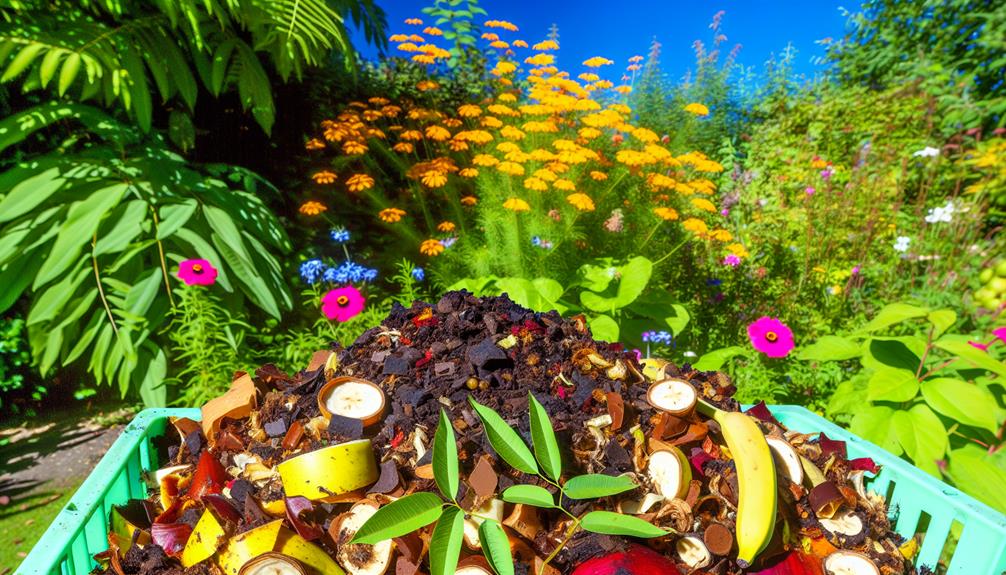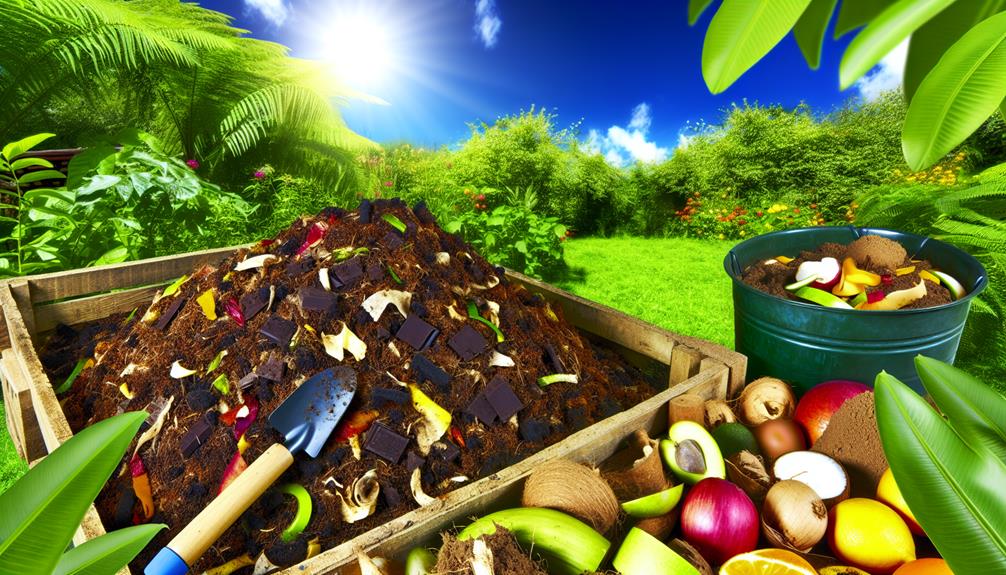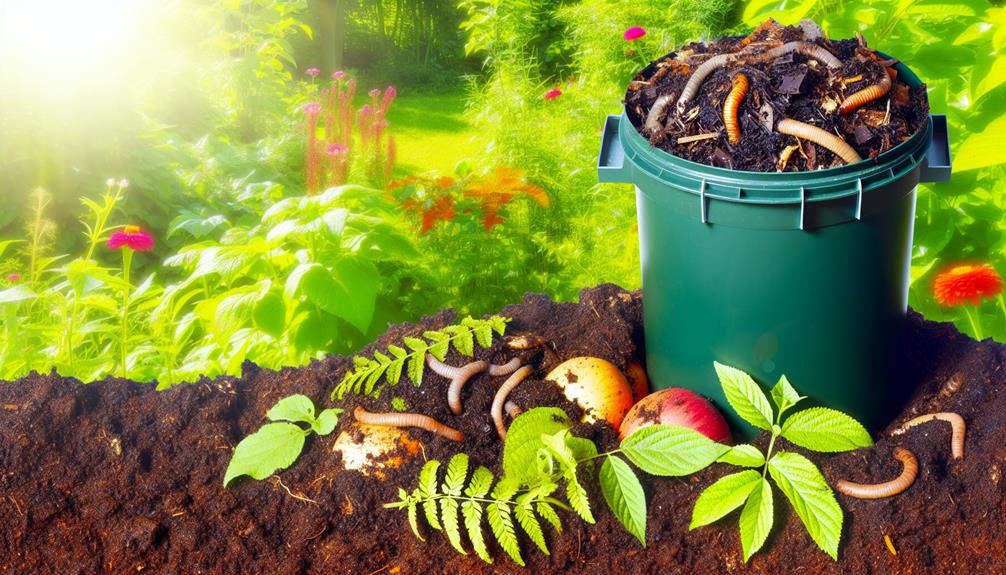

You can compost chocolate, but you’ll need to manage it carefully. Dark chocolate, with its higher cocoa content, breaks down easily and enriches the soil with essential nutrients. Milk chocolate, however, contains dairy and sugars that can attract pests, so balance it with brown materials like leaves.
Chop the chocolate into small pieces and layer it with green materials like fruit scraps. Maintain a 1:3 ratio of greens to browns for efficient composting. Regularly turn your compost to aerate it and monitor moisture levels to avoid clumping and odors. There’s more to explore regarding the benefits and techniques of chocolate composting.
When it comes to composting chocolate, you need to know which types are suitable for your compost bin. Not all chocolate is created equal when it concerns composting.
Dark chocolate and milk chocolate are the primary types you’ll encounter, and they’ve different composting properties. Dark chocolate, which contains higher cocoa content and fewer additives, is usually more straightforward to compost. The simpler ingredients break down more easily in your compost bin, contributing valuable nutrients to the mix. So, if you’ve got some leftover dark chocolate, feel free to toss it into your compost without much worry.
Milk chocolate, on the other hand, contains dairy and additional sugars. While it’s compostable, you need to be more cautious. Dairy can attract pests, and too much sugar can disrupt the balance of your compost pile. When adding milk chocolate, make sure to balance it with plenty of brown materials like leaves or cardboard to maintain a healthy compost environment.
Have you ever wondered how composting chocolate can benefit your garden and the environment? By composting chocolate, you’re not only enriching your soil but also contributing to waste reduction.
Soil Enrichment: Chocolate contains essential nutrients like nitrogen, phosphorus, and potassium. When you add it to your compost, these nutrients break down and enhance the quality of your soil, making it more fertile and beneficial for plant growth.
Waste Reduction: Instead of tossing chocolate scraps into the trash where they’d end up in a landfill, composting helps reduce waste. It’s an effective way to lower your carbon footprint and promote sustainable living.
Essential for: Chocolate can stimulate microbial activity in your compost pile. These microorganisms are essential for breaking down organic matter, speeding up the composting process, and producing nutrient-rich humus.
Also Read: Can You Compost Blood?
To start composting chocolate effectively, gather your chocolate scraps and mix them with other organic materials. This helps create a balanced composting process, aiding the chocolate break down efficiently. Begin by chopping larger chocolate pieces into smaller bits to speed up decomposition. Then, layer the chocolate with green materials like fruit scraps and vegetable peels, and brown materials such as leaves and cardboard.

Here’s a quick reference guide for your composting mix:
| Material Type | Examples |
|---|---|
| Chocolate | Scraps, broken pieces |
| Greens | Fruit scraps, veggie peels |
| Browns | Leaves, cardboard |
| Moisture | Water as needed |
Balancing nitrogen-rich greens and carbon-rich browns is essential. Aim for a ratio of roughly 1 part greens to 3 parts browns to maintain an ideal environment for microbes. Regularly turning your compost pile will also help aerate it, promoting faster breaking down of materials.
Keep an eye on moisture levels. Your compost should be damp but not waterlogged. Too much moisture can slow the composting process, while too little can stall it. By following these steps, you’ll ensure your chocolate scraps contribute positively to your compost pile.
Also Read: Can You Compost Body Wash?
One common pitfall in composting chocolate is neglecting to balance the moisture levels properly. Too much moisture can lead to a soggy, anaerobic mess, while too little can slow down the decomposition process. Chocolate’s sugar content and dairy presence can complicate things further. These components can attract pests and create unpleasant odors if not managed correctly.
To avoid these issues, consider the following:
Also Read: Can You Compost Ash From Natural Lump Charcoal?
Adding to our discussion on avoiding potential issues, let’s explore some additional tips to make your chocolate composting efforts more successful. First, make sure your compost bins are well-ventilated to prevent any unpleasant odors. Aeration is vital for speeding up the decomposition process and maintaining a healthy compost pile.

Next, balance your compost materials. Chocolate is rich in carbon, so you’ll need to add nitrogen-rich materials like vegetable scraps or grass clippings. This balance helps create nutrient-rich garden soil. Also, chop the chocolate into small pieces to accelerate decomposition.
Remember to turn your compost regularly. This helps distribute air and moisture evenly, fostering a thriving microbial community essential for breaking down materials. Moisture levels are also important; aim for a consistency similar to a wrung-out sponge.
Lastly, patience is key. Composting takes time, and rushing the process can result in incomplete compost.
Here’s a quick reference guide:
| Tip | Why It Matters |
|---|---|
| Ventilate compost bins | Reduces odors, speeds decomposition |
| Balance materials | Ensures nutrient-rich garden soil |
| Chop chocolate | Accelerates decomposition |
| Turn compost regularly | Distributes air and moisture evenly |
| Be patient | Ensures complete composting |
Yes, chocolate can attract pests to your compost bin. For effective pest control, make sure your compost location is well-managed and regularly turned. Keeping it balanced and covered will help you maintain a pest-free community compost.
Composting chocolate can affect your compost’s nutrient balance due to its cocoa content. Don’t worry, though. In moderation, it won’t drastically alter the pH. Just make sure to mix it well with other materials.
You’re wondering if it’s safe to compost chocolate with wrappers. If the wrappers are biodegradable, they’ll decompose well. However, non-biodegradable wrappers won’t break down and could harm your compost, so always check the materials first.
You’re wondering how long it takes for chocolate to decompose in compost. With high microbial activity, the decomposition rate is usually a few months. In a well-maintained compost, you’ll see faster results. We’re all in this together!
You can compost chocolate products with nuts or fruit. The added ingredients enhance the nutrient content and aid in the decomposition rate. Just make sure they’re in small pieces to integrate smoothly into your compost pile.
To sum up, you can compost chocolate, but it requires careful attention. Stick to dark chocolate, avoid additives, and break it into small pieces.
Incorporate it with a balanced mix of green and brown materials to guarantee proper decomposition. Watch out for pests and mold, adjusting as needed.
Composting chocolate can enrich your soil, benefiting your garden. Follow these guidelines, and you’ll successfully turn chocolate waste into valuable compost for your plants.
Happy composting!
